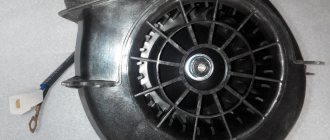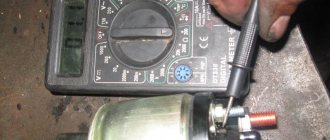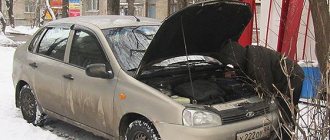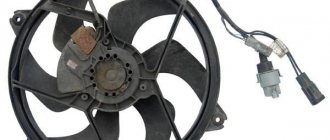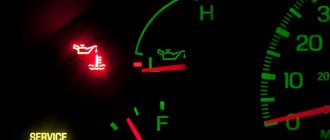Calm, just calm, as the Great Lord of the impeller said) Actually, everything is fine with me. Now. I am writing this post so that people whose working fuel pump suddenly stops working can find it in a search. I had this problem for a long time, and I suffered for a very long time, and did not know how to eliminate the consequences of this unknown crap, while flipping through a lot of information. And so, this morning, when at minus 35 the car did not start, and I stupidly forgot about this trick, and having drained the battery I almost went to work on a minibus, I again remembered what needed to be done. I'll tell you what the point is. The fuel pump just refuses to turn on. The brain should supply a minus voltage to the fuel pump turn-on relay, but for some reason it does not supply it periodically. Either a glitch in the brain, or a bug in the signaling. But I’m not the only one, and the problem, as it turns out, visits many.
What should we do if the fuel pump does not work when we turn on the ignition?
On the front passenger side we open the side of the torpedo, it is indicated under the number 3
Having opened the hatch, we see 3 pres and 3 relays. Mine is approximately as shown in the photo below. What should I do to make the car move? There are 2 options here:
1. The photo shows the negative contact. You need to pull out the relay a little, attach a wire to the relay contact, and throw it onto the body ground. After that, put the relay in place. What does it give? The fuel pump will start working when the ignition is turned on. I should immediately note that the fuel pump will work constantly. I just don’t recommend leaving the ignition on with this modification, because... You could burn out the fuel pump.
Option 2. Using the same principle, you need to close the positive contacts, they are shown in the photo. This procedure will allow you to start the fuel pump even with the ignition off, and you will be able to get to the service center, or wherever you planned to go.
Do not forget, after you have reached the place, to delete the modification data, because... I recommend using them only in emergency cases. Using it “on a regular basis” may not be safe and may lead to unpleasant consequences.
Gasoline (diesel) by itself cannot get from the car tank to the engine; for this you need a pumping mechanism - a fuel pump. And if it fails, the consequences are easy to predict - the machine will stop. There can be many possible reasons for this, and since they are typical for almost any brand of car, it is better to talk about them using a specific example. Let's say that the VAZ-2110 fuel pump does not work.
Reasons why the fuel pump does not pump gasoline when the ignition is turned on
The gasoline pump serves to supply fuel from the tank and maintain the pressure in the line necessary for the operation of the injectors. Interruptions in the supply of gasoline lead to a disruption in the composition of the air-fuel mixture, which leads to poor-quality combustion and misfires, the engine begins to stall, respond sluggishly to the gas pedal or stall. If the fuel pump (FP) does not pump, the engine will not start at all.
Operating principle of a mechanical fuel pump
The fuel pump is driven by the camshaft cam, which moves the pusher in a horizontal direction, causing it to perform reciprocating movements. The pusher, in turn, acts on the mechanical pumping lever, and it already raises and lowers the membrane rod.
Thus, a certain pressure is created inside the fuel pump, which is maintained by the valves of the device cover. One of them lets fuel in without letting it back in, and the second pushes it into the fuel line going to the carburetor.
As you can see, the design is very simple, therefore, to determine the reason that the fuel pump does not pump, it is enough to disassemble it and check the condition of the main elements.
Signs of fuel pump malfunctions
The main symptoms of fuel pump failure, as well as malfunctions in its operation, are:
- the car starts with difficulty, the engine runs unstable, there are dips, jerking when pressing the gas pedal, etc.;
- the pump does not pump after turning on the ignition, does not turn the starter and does not pump the fuel pump, the engine does not start;
There have also been cases when the fuel pump stops pumping while driving. In such a situation, the engine begins to malfunction and stalls immediately after the remaining gasoline in the fuel line is used up. The problem can occur either regularly or periodically.
Preventing fuel pump breakdowns
The best prevention for long-term operation of the fuel pump is its careful and proper operation, as well as compliance with the following rules:
- All scheduled vehicle repairs must be accompanied by the replacement of all fuel filters.
- It is necessary to monitor and ensure the cleanliness of the fuel tank and filters, as well as monitor the quality of the fuel being refilled (the absence of water, sand and other impurities in it).
- Eliminate the possibility of water getting into the fuel tank.
- Protect the fuel pump housing from mechanical stress that causes dents and cracks that contribute to the development of corrosion processes.
Sources
- https://FB.ru/article/281842/benzonasos-ne-kachaet-benzin-vozmojnyie-prichinyi-sposobyi-resheniya-problemyi
- https://avto-idea.ru/remont/kak-proverit-benzonasos-4-priznaka-polomki-i-5-etapov/
- https://autochainik.ru/priznaki-polomki-benzonasosa.html
- https://avto-lover.ru/drugoe/raspinovka-benzonasosa-vaz-2109-inzhektor.html
- https://russia-car-gid.ru/ne-kachaet-benzonasos-vaz-21099-2/
- https://www.vazzz.ru/vaz-2114-ne-shhelkaet-rele-benzonasosa-kak-diagnostirovat-polomku-remont-nasosa-katalozhnye-nomera/
- https://avtika.ru/pri-zapuske-dvigatelya-benzonasos-malo-kachaet-prichina/
- https://FB.ru/article/294613/benzonasos-ne-rabotaet-vozmojnyie-prichinyi-i-reshenie-problemyi
- https://autoclub.su/zamena-toplivnogo-nasosa-vaz-2114/
- https://vazweb.ru/desyatka/pitanie/zamena-toplivnogo-nasosa-vaz-2114.html
- https://KrutiMotor.ru/benzonasos-ne-kachaet-posle-vklyucheniya-zazhiganiya/
The fuel pump does not work, the relay turns on.
Checking relay power.
In the case when the fuel pump relay turns on when the ignition is turned on, but the pump itself does not work, you need to check the power at terminal 87 of the fuel pump relay. To do this, touch terminal 87 of the relay socket with the output of the control lamp connected to the vehicle ground, and the lamp should light up. If the lamp does not light, it means the fuse has blown or there is a break in the wire.
If there is power at terminal 87, you should remove the relay from the socket, and instead place a jumper between pins 87 and 30. In this case, if the pump and connecting wires are working properly, the pump should start working and if this happens, the relay should be changed. If the pump does not start working, then, without removing the jumper, you need to touch the power wire on the fuel pump with a test lamp connected to the vehicle ground.
Checking the fuel pump power circuit.
If a submersible pump is installed on the car as part of the fuel module, you need to remove the connecting connector and touch one of the thick wires. When you touch one of them, the indicator lamp should light up. If the lamp does not light up on any of the wires, then it is necessary to eliminate the break in the wire from the fuel pump relay to the module connector or the pump itself, if the pump is of a remote type. One of the reasons for the break may be the anti-theft blocking of an installed non-standard alarm system.
In the case when the test lamp lights up on one of the thick wires of the connector or one of the terminals of the remote pump, you need to connect these terminals with a test lamp to each other. In this case, the control lamp should light up. If the lamp does not light, it is necessary to eliminate a break or poor contact in the wire connecting the pump to the vehicle ground.
If, when checking the wires and relay for turning on the fuel pump, no malfunction is detected, the electric motor of the fuel pump or its connection to the module connector is faulty. It is not difficult to find the cause by removing the fuel pump module from the tank. If there is poor contact with the connector, melting of the plugs will be visible. If melting is not noticed, then to check the pump itself, you can connect it to the battery. It should be taken into account that operating a submersible pump without liquid will damage the pump. A faulty pump should be replaced.
Trouble-shooting
To repair a mechanical fuel pump, you will need to purchase a repair kit, which includes a diaphragm and valves - you can change these parts yourself. It will also not be difficult to replace the pusher with a spring. If the breakdown is more serious, then there is no point in resuscitation; it will be cheaper and easier to install a new fuel pump.
The electric fuel pump has a non-separable body, and it is not worth trying to repair it without certain skills; it is better to entrust such work to specialists. The only thing you can do yourself is to replace the mesh of the internal coarse filter. But even here you need to know that there are different types of meshes, so you will have to remove the filter from the tank to get a sample.
Signs of a fuel pump malfunction
Engine won't start
This is the main symptom of a faulty fuel pump. In the summer heat, a dying fuel pump may appear. The junction of the impeller with the rotor axis expands, and it rotates. You should check the fuel pressure from the rail and from the pump directly.
The service life of the fuel pump is determined by the owner's use of the vehicle. What is required for the fuel pump to last longer and not fail:
- Check the presence of water in the tank. For prevention, pour any pure alcohol into the tank. It mixes with water and burns out through the exhaust. There is a moisture displacer available in stores. Contains isopropyl alcohol.
Preventing fuel pump breakdowns
To extend the life of the fuel pump, you need to:
- Monitor the quality of fuel filled into the car.
- Completely eliminate even the possibility of water getting into the tank.
- During scheduled maintenance, be sure to change the fuel filters.
- In case of mechanical damage to the fuel tank, it is necessary to dismantle the fuel pump and check its condition.
- Periodically clean the fuel tank from possible accumulation of sediment, consisting of tiny solid particles found in gasoline.
Following these simple rules will have a beneficial effect not only on the fuel system, but also on the engine itself.
The fuel pump does not pump when the ignition is turned on
First of all, you need to check the fuel pump terminals and the power to them. In the photo, the terminals were worn out, which caused the contact to close and the fuel pump to melt.
What to do if such a situation arises. The verification algorithm is described below. Briefly check the presence of voltage at the fuel pump terminals. Based on this, further conclusions are drawn.
Checking the fuel pump circuit
Checking the power circuit.
If you know that the pump is working (to do this you need to gain access to it, remove it and connect it to an alternative power source), then the reason should be looked for in the car's wiring. To do this, the control light should be connected to the gray wire that goes to the pump.
This is exactly what is a plus. If the light does not light up, then power is not supplied to the unit.
Checking relays and fuses
Here you should initially check the fuses and relays. The fuse box is located behind the left of the driver under the dashboard, and therefore is not easy to access. You will have to unscrew two bolts and remove the decorative protective cover.
If these components are faulty, they should be replaced. The relay is checked in the same way as the pump, by connecting a test light to the input and output . The fuse can be checked visually.
The fuel pump relay is marked with a green arrow.
If the car still does not start, you should check the connector block. It is located behind the driver's side fuse box in the passenger compartment. Here you can also use a test light or tester, with which you can check the voltage at the inputs/outputs.
The fuel pump does not pump: causes and diagnostics
Let's start with the fact that if the gas tank is full, charged, dry and there is a spark, the starter turns the engine normally, but the engine does not seize, then you should pay attention to the gas pump. A common problem is that there is no power to the fuel pump after the ignition is turned on. In a similar way, the malfunction manifests itself in motion, when the power to the fuel pump is lost and the engine suddenly stalls.
An equally important point is how much the fuel pump pumps. In other words, the pump may hum and buzz (power is being supplied), but not create the required pressure in the fuel line. The pressure in the fuel system with a working fuel pump must be more than 3 bar (which depends on the specific car model). The indicated pressure is accumulated in the fuel rail and has an indicator of 300 kPa and above.
To check, you need to measure the pressure in the fuel rail with a pressure gauge, taking into account the indicators that are the norm for a specific car model. Using the example of injection VAZs, the pressure when the ignition is turned on is 3 atmospheres, at idle the figure is 2.5 atmospheres, when you press the gas 2.5-3 atmospheres. This method will help you accurately determine:
- malfunction of the fuel pressure regulator in the rail;
- breakdown of the fuel pump or a noticeable decrease in its performance due to wear;
- severe contamination of filters (fuel filter and/or fuel pump mesh);
In the second case, when you press the gas, the pressure does not increase; in the latter case, the pressure gauge needle rises, but very slowly or jerkily.
A decrease in pressure below the norm will lead to the fact that the engine may not start or start with difficulty, stall, jerk, operate unstably and with failures. If this happens due to the fault of the pump and not the fuel filter, then there is a high probability that the coarse filter screen of the fuel pump is clogged. In this case, there is no need, since it will be enough to replace or even clean the mesh.
If you suspect that there is no voltage to the fuel pump, there is a quick way to check. It is enough to turn the ignition key and listen, as when you turn the key you should hear a slight hum from the fuel pump. If such a buzzing noise is not heard, it means there is no power to the fuel pump, there are problems with the wiring, etc.
We add that this method of determining the operation of the pump by sound is not suitable for all cars. On some models (especially premium ones), sound insulation is at a high level and the fuel pump turns on immediately after opening the driver's door, and not when turning the key in the lock. In this case, it may seem that the fuel pump does not work when the ignition is turned on, and the sound of the pump may simply not be heard.
Also in the general list of possible reasons why the fuel pump does not pump, the following are noted:
- failure of the fuel pump fuse;
- fuel pump relay failure;
- problems with the ground of the fuel pump;
- malfunction of the electric motor of the fuel pump;
- oxidation or damage to fuel pump contacts and terminals;
- the fuel pump itself is faulty;
Wiring to the fuel pump
On most cars, the wiring to the fuel pump consists of three wires: “plus”, “minus”, and also a wire for indicating the amount of fuel in the gas tank. If the fuel pump does not pump, then the cause may be a lack of power.
To check the power to the fuel pump, just take a 12-volt light bulb and supply it with power from the external connector of the fuel pump. After turning the ignition, the control lamp should light up. If this does not happen, then the problem is in the external circuits. If the lamp comes on, it will indicate the need to check the internal contacts of the fuel pump.
To check the external wiring, you should alternately connect the positive and negative contacts, which are removed from the fuel pump power connector, to the ground of the pump. The contacts must also be connected to the fuel pump relay. If you place the negative contact on ground, after which the ignition is turned on and the light comes on, then this means that this contact is faulty. If the light bulb does not light up, then problems with the “plus” are obvious. If you place a contact on the relay and the light comes on, there is probably damage to the wire on the section that connects the relay and the fuel pump itself.
Fuel pump electric motor
If checking the pressure in the fuel rail and the external wiring to the fuel pump gives positive results, then you should check the fuel pump motor. This electric motor is responsible for circulating gasoline inside the fuel pump.
When checking, you need to take into account that the terminals on the fuel pump themselves tend to oxidize, as a result of which power is not supplied and the pump does not pump. In this case, the motor is working, but the terminals need to be cleaned or re-soldered.
To check the fuel pump motor, you will need to attach the test lamp wires to a cleaned and serviceable terminal of the electric motor, after which you should turn on the ignition. If the light comes on, this will indicate that the fuel pump motor is not working.
Fuel pump ground contact
Problems with the fuel pump mass may be indicated by a fuel level sensor that is not working correctly. The mass may be poorly secured; in this case, the fuel pump does not pump fuel. The ground wire is usually located under the dashboard and runs through the cabin. It is necessary to find the specified wire, check and clean all contacts, then securely fasten the ground to the fuel pump.
The fuel pump relay is often mounted next to the fuel pump ground, that is, under the dashboard. A normally operating relay after turning on the ignition for a couple of seconds allows the pump to create pressure in the system and immediately turns off.
When the ignition key is turned, the driver hears a characteristic click (the relay is turned on), then a similar click will indicate that the fuel pump relay is turned off. If such clicks are not heard, this indicates a malfunction of the relay or its contacts. The optimal solution would be to replace the fuel pump relay with a new or known-good device. Let us add that the cost of spare parts is quite affordable.
Fuel pump fuse
During diagnostics, be sure to check the fuel pump fuse. The specified 15 A fuse is usually located in the fuse box in the engine compartment and is marked FUEL PUMP, which means fuel pump.
The fuel pump fuse needs to be pulled out and its contact inspected. The integrity of the contact will indicate that the device is normal. A damaged contact will indicate that the fuel pump fuse has blown. In this case, you need to install a new fuse, which has a very low cost (as in the situation with the fuel pump relay).
The principle of operation of the fuel pump
The operation of the pump is controlled by a controller. At the same time, its control scheme is quite interesting. There is no pressure sensor in the car system, and therefore it is maintained by a pressure regulator. It is located near the pump in the tank.
New and old fuel pressure regulator
The regulator has a valve that can open only at a certain moment, namely when there is sufficient pressure in the system (4 Bar).
In this case, fuel will not flow into the return line either. When the ignition is turned on, the pump begins to pump fuel into the system, after which the regulator valve opens and remains in this position throughout the engine operation.
Design and operation of fuel supply
The system that provides the engine with the required amount of gasoline operates according to the following algorithm:
- After turning on the ignition, the electric fuel pump starts, raising the pressure in the line after itself to a certain level. The electrical power supply circuit of the unit is protected by a fuse.
- The fuel pressure regulator (common abbreviation - RDT) is located on the line after the pump and limits the upper pressure threshold, dumping excess fuel back into the tank through a separate pipeline.
- When the crankshaft is rotated by the starter and the engine continues to operate, fuel enters the fuel rail, mixes with air and is directed to the injectors built into each cylinder. The amount of mixture supplied to the combustion chambers is controlled by an electronic unit.
- On the way to the fuel rail, gasoline goes through 2 stages of filtration. The first is a mesh installed in the tank on the suction pipe of the pump, the second is a fine filter on the gas supply line.
Reference. In various car models, 2 schemes are used for installing the RTD and laying the return pipeline - in the engine compartment or directly in the gas tank. In the first case, the standard fuel pressure in the system is 2.7...3.0 Bar, in the second - 3.8...4 Bar.
A common mistake made by ignorant car enthusiasts: if the combustible mixture does not enter the cylinders, then the fuel pump is definitely not working. Knowing the design of the fuel supply, we can assume other problems:
- the protective fuse in the electrical circuit has blown, the pump is in good working order, but does not receive power;
- the primary or secondary filter is clogged (sometimes both at once), fuel flows in small quantities or does not flow at all;
- the pressure regulator has become unusable, dumping the lion's share of the fuel back into the tank, the engine gets nothing;
- One or more injectors have failed.
To accurately determine the source of the problem, you need to check the operation of the electric fuel pump and other elements. It is not necessary to go to a service station - diagnostic work can be carried out in your own garage.
How to remove the fuel pump Cherie Amulet
- Be sure to turn off the power to the on-board electrical system. We simply remove the negative terminal from the battery .
- Open the trunk and raise the flooring . For ease of work, you can remove the rolling tool and the tool lying next to it.
- Open the cover behind which the fuel module is hidden. The lid is held on by 3 screws.
Fault repair
If there is no power to the block, we begin troubleshooting by checking the fuses of the fuel pump power supply circuit. They are located on a special separate panel located in the car interior under the glove compartment.
Fuel pump fuse VAZ 2107
The middle relay and fuse F3 located nearby are responsible for the operation of the fuel pump.
1 – fuse, power circuits of the main relay;
The principle of operation of the fuel pump
The operation of the pump is controlled by a controller. At the same time, its control scheme is quite interesting. There is no pressure sensor in the car system, and therefore it is maintained by a pressure regulator. It is located near the pump in the tank.
New and old fuel pressure regulator
The regulator has a valve that can open only at a certain moment, namely when there is sufficient pressure in the system (4 Bar).
In this case, fuel will not flow into the return line either. When the ignition is turned on, the pump begins to pump fuel into the system, after which the regulator valve opens and remains in this position throughout the engine operation.
What types of fuel pumps are there?
Cars with gasoline engines, depending on the make, model and modification, can be equipped with gasoline pumps of different designs.
But they all fall into two main categories: mechanical and electrical. Most carburetor engines are equipped with mechanical fuel delivery devices. If we take the VAZ 2109 (carburetor), then from the factory it was equipped with a diaphragm pump manufactured by DAAZ. The main difference of this device is its simplicity of design, which is easy to understand even for a beginner. In the carburetor "nine" the fuel pump is located in the engine compartment of the car. It is easy to recognize by its characteristic hemispherical cap and fuel line hoses. VAZ 2114 injection engines are equipped with electric fuel pumps. Their design is also based on a membrane, but unlike “mechanics”, the fuel supply devices in cars with automatic fuel injection are not under the hood, but directly in the tank.
